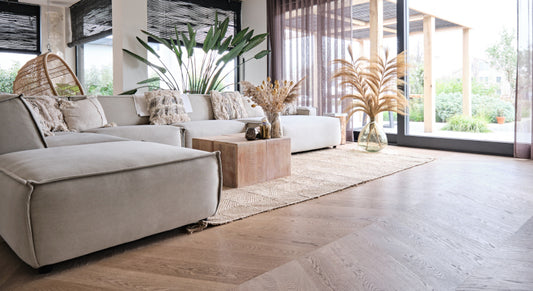De Walvisgraat

Datum: 24 augustus 2023
Leestijd: 6 minuten
Auteur: Uipkes Houten Vloeren
The term “whale bone” may conjure up images of majestic sea creatures swimming through the ocean. But in the world of interior design and architecture, a whalebone floor is a symbol of elegance, luxury and craftsmanship. In this article we discuss the origins, properties, applications, advantages and disadvantages of the floor.
Bezoek de showroom
To arise
The whale bone owes its name to the pattern that resembles the skeleton of a whale. The floor is descended from theherringbone floor, which has a rich history and dates from the time of Roman architecture. Over the centuries it has developed into a style associated with luxury and refinement. Originally made of natural wood, variants such as laminate and ceramic tiles are now also available. The whale bone is a relative of the herringbone, but the whale bone consists of larger/wider planks.
Characteristics
The distinctive "V" shaped patterns make the whalebone floor unique and visually appealing. In addition, the material, often high-quality wood, provides a durable and comfortable surface. The technique for installing this pattern is labor intensive and requires a high degree of craftsmanship, which contributes to the exclusivity of these floors.
Applications
Whalebone floors are not only popular in residential settings, but also find their way into commercial spaces such as offices and hotels. They are suitable for both classic and modern interiors and can be treated in different ways to achieve variations in color and finish.
Advantages
- Aesthetic Appeal: The unique patterns add a layer of complexity and elegance to any space.
- Durability: High-quality materials and craftsmanship make these floors extremely durable.
- Increased Value: The luxurious appearance can increase the value of a property.
Cons
- Higher investment: The materials and craftsmanship required to install these floors can be more expensive than a straight pattern.
- Installation time: Installing a whalebone floor is a time-intensive process.
Bekijk ons Magazine Vol inspiratie
Overview Of Materials
In addition to traditional wood, whalebone floors can also be made from several other materials, including:
- Wood: A natural material, which can also be sustainable. Thanks to the arrival of composite planks, it can also be combined with underfloor heating .
- Laminate: A cost-effective option that mimics the look of a whalebone floor without the use of real wood.
- Ceramic Tiles: These tiles can be finished to resemble wood and provide a durable and water-resistant alternative.
- PVC: This consists of a layer of real wood on top and several layers of engineered wood species underneath, which provides extra stability.
Whalebone and underfloor heating: a combination?
Underfloor heating is becoming increasingly popular as an efficient and even way to heat a room. The good news is that many modern whalebone floors are ideally suited with underfloor heating systems. The key to this application lies in the choice of material and thickness of the planks. Wooden floors over underfloor heating (in the case of composite planks) are often a good choice because it is less sensitive to temperature changes and humidity than solid wood. Additionally, thinner planks transmit heat better than thicker options, optimizing the efficiency of the heating system. However, it is crucial to carefully consider both the underfloor heating and floor specifications. Close collaboration with professionals can ensure a harmonious integration of these two elements, resulting in a living space that is both stylish and functional.
Liever thuis advies op maat?
Trends And Innovations
In recent years we have seen trends such as the use of recycled or sustainably produced materials, making the whalebone floor a more environmentally friendly choice. In addition, modern finishing techniques such as UV lacquers and oil treatments make it easier to maintain the floor without losing its beauty.
Future Perspectives
The whalebone floor remains an icon of elegance and luxury. With modern technologies and materials it is now possible to make this classic design more accessible and sustainable. Although it may require a significant investment, both in terms of cost and maintenance, it remains a choice that can significantly increase the aesthetic and financial value of a space.
Kom Langs Voor Een Adviesgesprek
Geïnteresseerd in een walvisgraat voor jouw woning? Kom langs in de showroom om de mogelijkheden te bespreken.
Frequently Asked Questions
What is a whale bone?
A whalebone floor is a type of wooden floor in which the planks are placed in a characteristic V-pattern. The wide planks make the structure resemble a whale skeleton.
What is the difference between whale bone and herringbone?
Both patterns are similar, but the whalebone planks are generally wider and are installed in a more parallel and less broken V-shape.
Why should I choose a whale bone?
In addition to the aesthetic appeal, these floors are also very durable and can increase the value of a home. The wide planks provide peace and a modern look.
Are whalebone floors environmentally friendly?
This depends on the material used. Today, sustainably sourced wood options and other eco-friendly materials are available. Please note that not every floor type is durable.
Is a whale bone suitable for underfloor heating ?
Yes, many modern whalebone floors are suitable for underfloor heating , but it is important to check this with the manufacturer in advance.
Stay up to date with news about floors and interior




